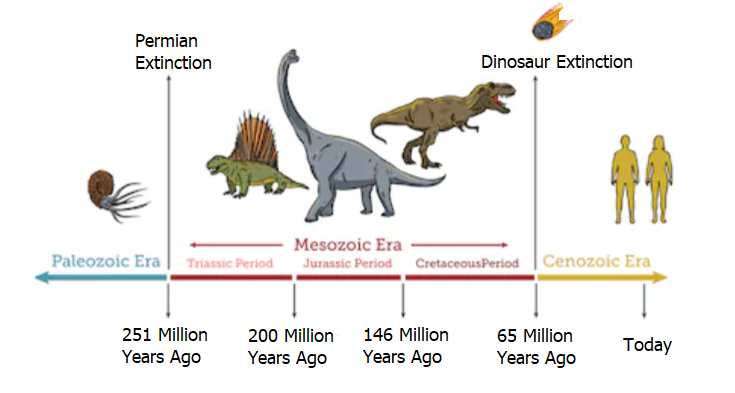
The reptiles, like dinosaurs, were dominant in _ _ _ _ _ period.
A. Cretaceous
B. Jurassic
C. Tertiary
D. Triassic
Answer
577.2k+ views
Hint: Reptiles were present in the Jurassic period of the Mesozoic era. Mesozoic era, also referred to as the Middle Life era is considered as the age of enormous reptiles such as dinosaurs and other types of beasts. Some important organisms involving both vertebrates and invertebrates first appeared during this Jurassic period.
Complete answer:
Jurassic rocks include clays and calcareous stones which prevail in fossil flora and fauna. Plants featured ferns, cycads, ginkgos, conifers, and rushes. Ammonites (on which the Jurassic is zoned), corals, brachiopods, bivalves, and echinoids constituted important invertebrates.
Late Paleozoic Life
Carboniferous, Amphibian Age; amphibians were the prevalent Carboniferous land animals; there were many species like lizard-like, snake-like, crocodile-like; some were very large, but Carboniferous amphibians (like today's frogs and salamanders) had to lay their eggs in water so that they did not dry out and die; Age of cockroaches; massive Pennsylvanian insects; dragonfly to around 1 meter.
Mid-Carboniferous, first amniotes, this group of amphibians (tetrapods) formed an amniotic shell that allows for oxygen in but water can not escape; the first amniotes give rise to two essential lines (1) reptiles and (2) reptile-like synapsids;
the birds originated from reptiles and mammals originated from synapsids in the Mesozoic.


Permian drying allowed the amniotes to take over the leading position of terrestrial animals because of their reproductive advantage (there was no need to lay eggs in the water);
the Permian is also referred to as the "Reptile Era" although it is now clear that the prevailing "reptiles" were the synapsids that later gave birth to mammals, not to a lineage of modern reptiles.
So, the option (B) is correct
Note: Jurassic The second Mesozoic Geological Period. This preceded the Triassic, which began about 213 million years ago and lasted around 144 million years ago until the beginning of the Cretaceous era. A was given to it in 1829.
Brongniart on the frontier between France and Switzerland, following the Jura Mountains.
Complete answer:
Jurassic rocks include clays and calcareous stones which prevail in fossil flora and fauna. Plants featured ferns, cycads, ginkgos, conifers, and rushes. Ammonites (on which the Jurassic is zoned), corals, brachiopods, bivalves, and echinoids constituted important invertebrates.
Late Paleozoic Life
Carboniferous, Amphibian Age; amphibians were the prevalent Carboniferous land animals; there were many species like lizard-like, snake-like, crocodile-like; some were very large, but Carboniferous amphibians (like today's frogs and salamanders) had to lay their eggs in water so that they did not dry out and die; Age of cockroaches; massive Pennsylvanian insects; dragonfly to around 1 meter.
Mid-Carboniferous, first amniotes, this group of amphibians (tetrapods) formed an amniotic shell that allows for oxygen in but water can not escape; the first amniotes give rise to two essential lines (1) reptiles and (2) reptile-like synapsids;
the birds originated from reptiles and mammals originated from synapsids in the Mesozoic.


Permian drying allowed the amniotes to take over the leading position of terrestrial animals because of their reproductive advantage (there was no need to lay eggs in the water);
the Permian is also referred to as the "Reptile Era" although it is now clear that the prevailing "reptiles" were the synapsids that later gave birth to mammals, not to a lineage of modern reptiles.
So, the option (B) is correct
Note: Jurassic The second Mesozoic Geological Period. This preceded the Triassic, which began about 213 million years ago and lasted around 144 million years ago until the beginning of the Cretaceous era. A was given to it in 1829.
Brongniart on the frontier between France and Switzerland, following the Jura Mountains.
Recently Updated Pages
Master Class 12 Business Studies: Engaging Questions & Answers for Success

Master Class 12 Economics: Engaging Questions & Answers for Success

Master Class 12 English: Engaging Questions & Answers for Success

Master Class 12 Maths: Engaging Questions & Answers for Success

Master Class 12 Social Science: Engaging Questions & Answers for Success

Master Class 12 Chemistry: Engaging Questions & Answers for Success

Trending doubts
Who was the first woman to receive Bharat Ratna?

Write a letter to the principal requesting him to grant class 10 english CBSE

Why is there a time difference of about 5 hours between class 10 social science CBSE

What is the median of the first 10 natural numbers class 10 maths CBSE

The Equation xxx + 2 is Satisfied when x is Equal to Class 10 Maths

Discuss the main reasons for poverty in India




